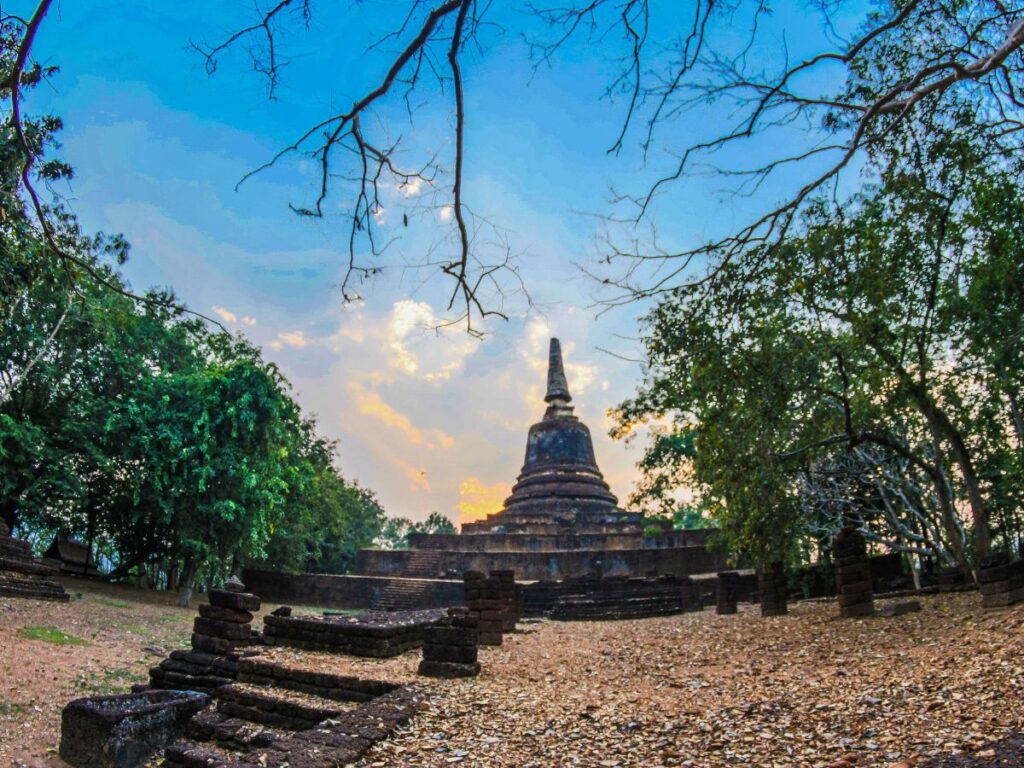Si Satchanalai might not be the first name that pops up when planning a Thailand trip, but for travelers who love history, peaceful landscapes, and slow exploration, it’s a dream come true. Located just north of Sukhothai’s more famous historical city, this lesser-known area offers a calm alternative filled with cultural richness and timeless ruins that still retain their character. Si Satchanalai is one of the most underrated answers to what to see in Sukhothai.

If you’re searching for what to see in Sukhothai beyond the main tourist loop, Si Satchanalai is where the magic lives quietly. Think ancient temples with mossy bricks, villages where artisans still work by hand, and roads that twist gently through rice fields and forested hills. It’s a place to walk, learn, and take your time.
Step Back in Time — Why Si Satchanalai Deserves a Spot on Your Itinerary
Si Satchanalai was once a key satellite city of the Sukhothai Kingdom, a spiritual and political center with deep influence during the 13th-15th centuries. Today, its ruins are preserved as part of a UNESCO World Heritage Site, but what sets it apart is the atmosphere — much quieter, more open, and with fewer crowds than Sukhothai Old City.
Exploring Si Satchanalai feels like entering a living museum. The historical park is large, with trails that pass through clusters of ruins, Buddhist stupas, and restored architecture that shows off the kingdom’s artistic style. It’s the kind of place where you can cycle under tree canopies and still hear birdsong instead of engines. This organic setting is one of the many reasons Si Satchanalai stands out when considering what to see in Sukhothai.
Top Historical Sights in Si Satchanalai Historical Park
If you only have a day to explore, these are the must-see highlights within the Si Satchanalai Historical Park — a must-stop for anyone compiling a list of what to see in Sukhothai:
Wat Chang Lom
One of the most photographed temples in the park, Wat Chang Lom is famous for its 39 elephant sculptures surrounding the main stupa. These life-sized guardians give the structure a majestic energy and hint at the spiritual symbolism of elephants in Thai Buddhism.
- How to get there: Wat Chang Lom is located within Si Satchanalai Historical Park, about 55 km north of Sukhothai city. From Sukhothai, the easiest way to reach the park is by private car or hired taxi, which takes around 1 hour via Route 101 and Route 1201.
- Google Maps: https://maps.app.goo.gl/TE7akCBFVH6NssYEA
Wat Chedi Chet Thaeo
Meaning “temple of seven rows of chedis,” this area has over 30 smaller stupas built in different styles, believed to be royal family tombs. Walking through feels like wandering a royal cemetery from centuries past — serene, solemn, and full of character.
- How to get there: Also situated inside Si Satchanalai Historical Park, Wat Chedi Chet Thaeo is just a short ride from other major ruins. If you’re already at Wat Chang Lom, you can cycle or walk about 3–5 minutes through shaded pathways to reach it.
- Google Maps: https://maps.app.goo.gl/TE7akCBFVH6NssYEA
Wat Nang Phaya
Though smaller in scale, this temple is celebrated for its stucco carvings that have survived centuries. The patterns here reflect the artistic finesse of Sukhothai artisans and offer a more intimate viewing experience.
- How to get there: Wat Nang Phaya lies within the eastern zone of the historical park and is best accessed after visiting Wat Chedi Chet Thaeo. From the main entrance, it’s approximately 10 minutes by bicycle, following signposted park roads.
- Google Maps: https://maps.app.goo.gl/TfJ2dxkSTA8Db4iVA
Wat Khao Suwan Khiri
Perched on a low hill with sweeping views over the entire site, this temple rewards a short hike with a quiet overlook. Great for sunrise photography and those looking to appreciate the park’s full scale from above.
- How to get there: Wat Khao Suwan Khiri is perched on one of the higher ridges inside Si Satchanalai Historical Park. From the main entrance of the park, head toward Wat Khao Phanom Phloeng and follow the ridge trail north for about 200 meters, passing Chao Mae La-Ong Sam Lee Shrine. At the saddle of the ridge, climb a short stairway up to reach the temple.
- Google Maps: https://maps.app.goo.gl/ynwEsQBkZfun83kc9
Wat Phra Si Rattana Mahathat Chaliang
Technically outside the main park area, this towering Khmer-influenced temple shows the cultural crosscurrents that shaped the region before and during the Sukhothai era. The scale alone makes it worth the detour and a vital part of what to see in Sukhothai for architecture lovers.
Each temple is marked by signage in English and Thai, and most paths are navigable by bike. Bicycle rentals (price is around 30-50 baht) are available near the main entrance.
- How to get there: Wat Phra Si Rattana Mahathat Chaliang lies east of the historic walled town of Chaliang, on a small peninsula almost surrounded by the Yom River. From Sukhothai town, you can take a local bus toward Si Satchanalai. The ride takes roughly 1 hour 30 minutes.
- Google Maps: https://maps.app.goo.gl/uyDRwCigKaTZFc9LA
Beyond the Ruins: Craft Villages, Local Culture, and Scenic Views
Si Satchani isn’t just a destination for stone ruins, it’s a living cultural hub where traditional lifestyles and local skills are still practiced. This blend of history and living culture makes it a key stop when deciding what to see in Sukhothai with depth.
Ban Had Siew
This weaving village is famous for its vibrant textiles dyed with natural indigo and woven into intricate geometric patterns. Stop by the community weaving center to watch artisans at work and buy directly from the makers.
Celadon Kilns and Ancient Pottery
The Si Satchanalai region was once a thriving ceramics producer. Today, the Ban Koh Noi Kilm Site Museum preserves ancient kilns and pottery shards that tell the story of Thailand’s ceramic trade centuries ago. Some local workshops still create celadon wares using traditional techniques.
Scenic Spots Along the Yom River
The riverside offers gentle walking paths, sunset views, and chances to spot locals fishing with bamboo traps. You’ll also find quiet picnic spots — perfect for resting with a Thai iced coffee and taking it all in.
Local Food
When thinking about what to see in Sukhothai, don’t forget to taste it too. Try dishes like Khao Perb (steamed noodle sheet rolls) or banana blossom curry at a local roadside shop or morning market. You’ll eat well and cheap!
Where to Stay Near Si Satchanalai: Peaceful Picks for Culture Lovers
Unlike Sukhothai Old City, accommodation around Si Satchanalai is limited, but a few peaceful options are within 10-20 km of the historical park and worth considering if you want a quiet retreat after exploring what to see in Sukhothai:
- Sila Resort – Located in Sawankhalok town (approx. 20 km south), this riverside guesthouse offers a laid-back vibe, with private rooms and bungalows set in a garden. A good base if you prefer being closer to shops and transport.
- Sabai Sabai Sukhothai – A charming family-run guesthouse located between Si Satchanalai and Sukhothai town. Basic rooms but known for warm hospitality and local knowledge.
- Ban Na Ton Chan Homestay – A traditional homestay in a heritage village with wooden houses, weaving demonstration, and local food. Ideal for those who want a deeper cultural connection and don’t mind rustic comfort.
Most accommodation can help arrange transport to the park or provide bicycles. Booking ahead is recommended, especially during holiday seasons or weekends.
How to Get There from Bangkok or Sukhothai Old City
Getting to Si Satchanalai is straightforward if you plan ahead:
- From Bangkok
Take a bus from Mo Chit Terminal to Sukhothai (approx. 6-7 hours, the price is around 300-400 baht). From there, hire a private car or minivan (the price is to be negotiated) to Si Satchanalai, about 60 km north. If you’re confident driving, a rental car is the most flexible option — via Route 117 through Phitsanulok and then Highway 101.
- From Sukhothai Old City
The easiest way is by car or taxi (about 1-1.5 hours). Public songthaews and motorbike rentals are available but less convenient for first-timers. Local buses toward Sawankhalok also pass nearby — check departure times at the Sukhothai bus station.
The journey is part of the experience, from paddy fields to mountain backdrops, it’s a scenic route that slowly shifts you into a different pace of travel. And for those seeking what to see in Sukhothai with intention, that shift is exactly the point.
There’s no single attraction that defines Si Satchanalai — it’s the atmosphere, the layered history, and the connection between land, craft, and community that makes it special. This is a place to slow down, look closely, and let the past unfold gently.
So if your list of what to see in Sukhothai is still open, make room for this peaceful gem. You won’t find crowds or flashy cafés, but you will find meaning, memory, and stillness, the kind that stays with you long after the trip is over. Let Si Satchanalai redefine what to see in Sukhothai for your next journey.
Share




